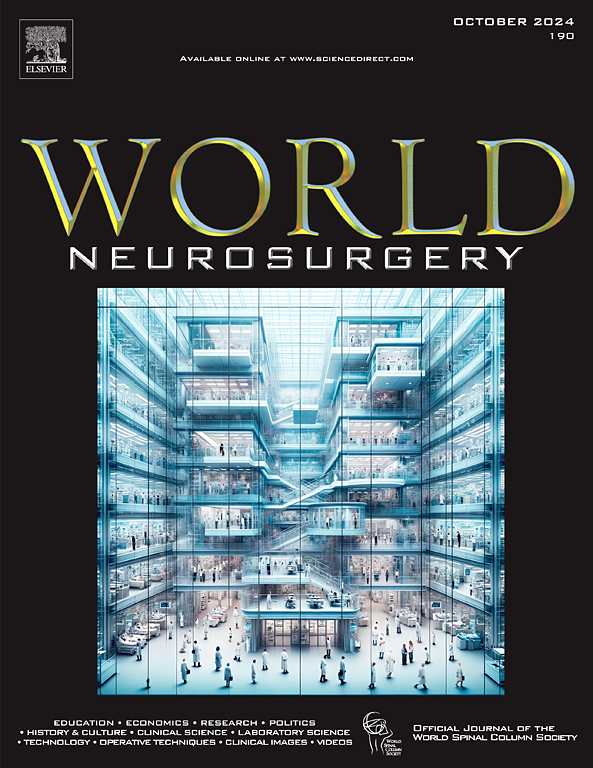Surgical Efficacy Analysis of Traumatic Posterior Fossa Epidural Hematoma in Children
IF 1.9
4区 医学
Q3 CLINICAL NEUROLOGY
引用次数: 0
Abstract
Objective
To investigate the treatment effect and prognosis of posterior fossa epidural hematoma in children by different surgical methods.
Methods
The clinical data of 41 children with traumatic posterior fossa epidural hematoma treated by surgery in the Department of Neurosurgery from June 2015 to October 2023 were retrospectively analyzed. Among them, 32 cases underwent minimally invasive skull trepanation and drainage and 9 cases underwent craniotomy and hematoma removal. The therapeutic effects and prognosis of the two surgical methods were analyzed.
Results
All the cases were successfully treated by operation. The operation time and intraoperative blood loss of the children who underwent minimally invasive skull trepanation and drainage were significantly reduced compared with those who underwent craniocerebral hematoma removal (P < 0.05), but there was no significant difference in the postoperative ventilator withdrawal time, hospitalization days, and postoperative complications between the two groups (P > 0.05). After 4 months to 2 years of follow-up, all the children recovered well, and no children died or became disabled after surgery.
Conclusions
The effect of minimally invasive skull trepanation and drainage in the treatment of posterior fossa epidural hematoma in children is similar to that of craniotomy hematoma removal, but the operation is simpler, less trauma, less intraoperative bleeding, and short operation time, which is worthy of clinical application.
儿童外伤性后窝硬膜外血肿的手术疗效分析
目的方法:回顾性分析2015年6月-2023年10月神经外科手术治疗的41例外伤性硬膜外后窝血肿患儿的临床资料:回顾性分析2015年6月至2023年10月神经外科手术治疗的41例外伤性后窝硬膜外血肿患儿的临床资料。其中32例行微创颅骨穿刺引流术,9例行开颅血肿清除术。分析了两种手术方法的治疗效果和预后:结果:所有病例均成功接受手术治疗。结果:所有病例均成功接受了手术治疗,接受微创开颅引流术的患儿手术时间和术中失血量较接受颅脑血肿清除术的患儿明显减少(P0.05)。经过4个月至2年的随访,所有患儿均恢复良好,没有患儿在术后死亡或致残:微创颅骨穿刺引流术治疗儿童后窝硬膜外血肿的效果与开颅血肿清除术相似,但手术更简单,创伤小,术中出血少,手术时间短,值得临床应用。
本文章由计算机程序翻译,如有差异,请以英文原文为准。
求助全文
约1分钟内获得全文
求助全文
来源期刊

World neurosurgery
CLINICAL NEUROLOGY-SURGERY
CiteScore
3.90
自引率
15.00%
发文量
1765
审稿时长
47 days
期刊介绍:
World Neurosurgery has an open access mirror journal World Neurosurgery: X, sharing the same aims and scope, editorial team, submission system and rigorous peer review.
The journal''s mission is to:
-To provide a first-class international forum and a 2-way conduit for dialogue that is relevant to neurosurgeons and providers who care for neurosurgery patients. The categories of the exchanged information include clinical and basic science, as well as global information that provide social, political, educational, economic, cultural or societal insights and knowledge that are of significance and relevance to worldwide neurosurgery patient care.
-To act as a primary intellectual catalyst for the stimulation of creativity, the creation of new knowledge, and the enhancement of quality neurosurgical care worldwide.
-To provide a forum for communication that enriches the lives of all neurosurgeons and their colleagues; and, in so doing, enriches the lives of their patients.
Topics to be addressed in World Neurosurgery include: EDUCATION, ECONOMICS, RESEARCH, POLITICS, HISTORY, CULTURE, CLINICAL SCIENCE, LABORATORY SCIENCE, TECHNOLOGY, OPERATIVE TECHNIQUES, CLINICAL IMAGES, VIDEOS
 求助内容:
求助内容: 应助结果提醒方式:
应助结果提醒方式:


